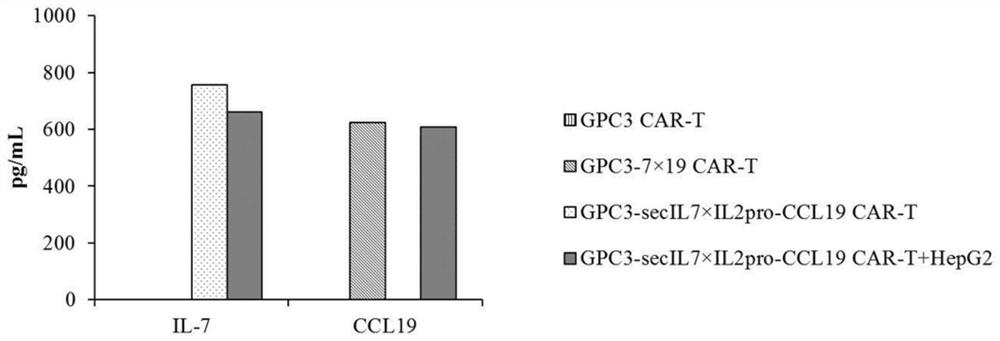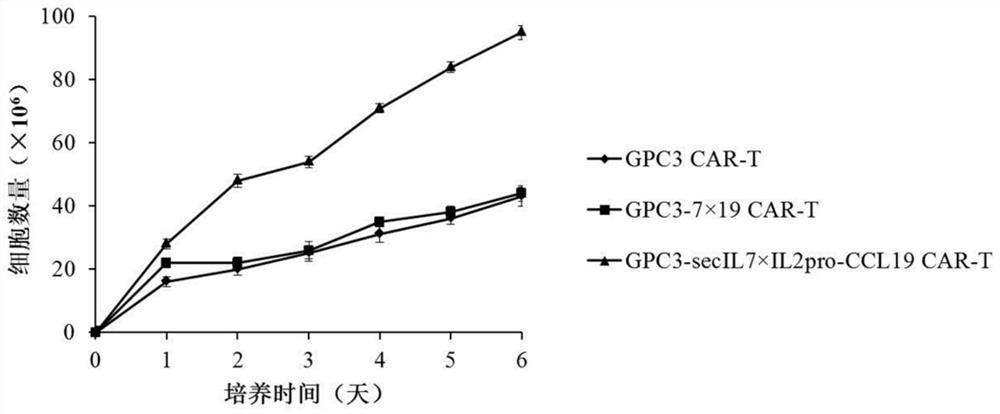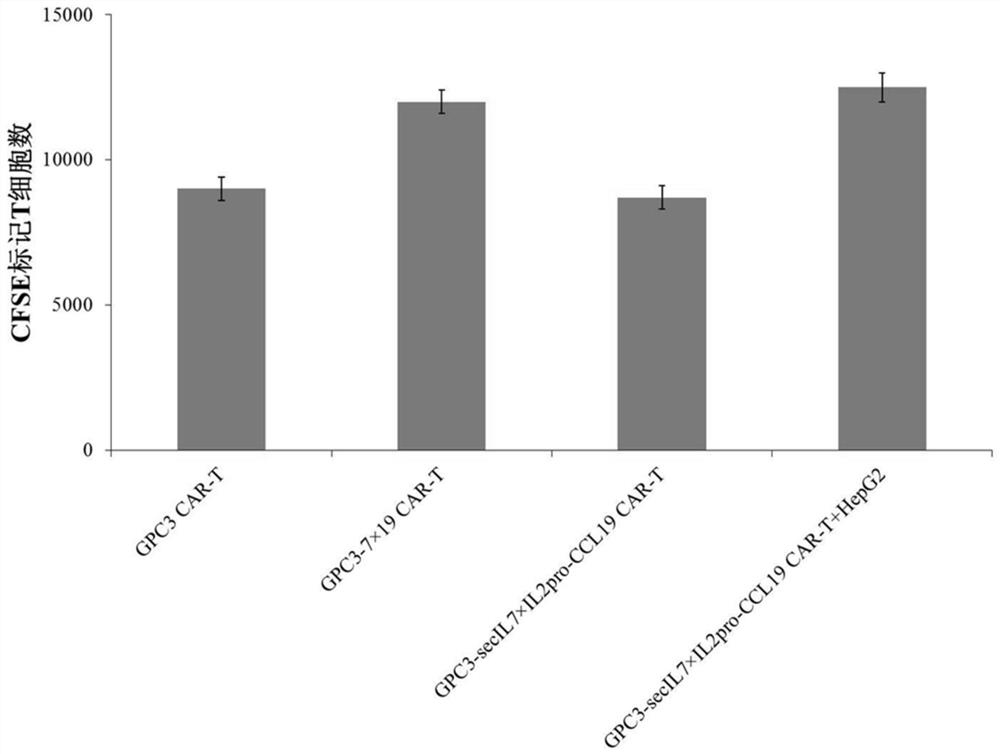CAR-T cell for expressing immune regulation factors and application thereof
An immune regulation and cell technology, applied in the field of biomedicine, can solve the problems such as the inability of peripheral blood immune cells to be recruited into the tumor and the inability to secrete exogenous IL-7 protein, so as to improve the anti-tumor efficiency and enhance the effect of tumor inhibition.
- Summary
- Abstract
- Description
- Claims
- Application Information
AI Technical Summary
Problems solved by technology
Method used
Image
Examples
Embodiment 1
[0058] The preparation of embodiment 1 lentiviral vector
[0059] Whole-gene synthesis of the following nucleic acid molecules:
[0060] ① A CAR molecule formed in series by the nucleic acid sequences of CD8α signal peptide, anti-GPC3 single-chain antibody, CD8α transmembrane domain, 4-1BB and CD3ζ (the amino acid sequence is shown in SEQ ID NO: 4);
[0061] ② IL-7 signal peptide (SEQ ID NO: 9) and IL-7 (without IL-7 signal peptide) (SEQ ID NO: 6), 2A peptide (SEQ ID NO: 10) and CCL19 (SEQ ID NO :8) the nucleic acid molecules formed in series by the nucleic acid sequences;
[0062] ③ A secreted IL-7 molecule formed by tandem nucleic acid sequences of IFN-γ signal peptide (SEQ ID NO:5) and IL-7 (without IL-7 signal peptide) (SEQ ID NO:6);
[0063] ④ A conditional CCL19 molecule formed by tandem 5×NFAT-RE-IL-2 promoter (SEQ ID NO:7) and CCL19 (SEQ ID NO:8);
[0064] SEQ ID NO: 9:
[0065] atgttccatgtttcttttaggtatatctttggacttcctcccctgatccttgttctgttgccagtagcatcatct;
[0066] ...
Embodiment 2
[0069] Example 2 Recombinant lentiviral packaging
[0070] In this example, 293T cells were used to prepare recombinant lentiviruses, and when the 293T cells spread to 80-90% of the bottom of a 100mm culture dish, the lentiviruses were packaged:
[0071] Cultivate 293T cells in a 10cm culture dish, the medium is DMEM high glucose medium + 10% FBS (fetal bovine serum) + 1% double antibody (100 × penicillin-streptomycin mixed solution); 293T cells in the culture dish When the density reaches 80%, replace the medium with DMEM high glucose medium + 1% FBS + 1% double antibody;
[0072] Prepare the plasmid mixture shown in Table 1, pWPXLd-expression plasmids include lentiviral vectors expressing CAR molecules, lentiviral vectors expressing complete IL-7 and CCL19, or lentiviral vectors expressing secreted IL-7 and conditional CCL19 carrier;
[0073] Table 1
[0074] Reagent dose pWPXLd-expression plasmid 4.5μg pMD2.G 1.5μg psPAX2 6μg
[0075...
Embodiment 3
[0081] Example 3 Preparation of CAR-T cells expressing IL-7 and CCL19
[0082] (1) Peripheral blood mononuclear cells (PBMC) were separated from whole blood by Ficoll density gradient centrifugation kit (GE Company), and after red blood cells were removed, T cells were sorted by MACS Pan-T magnetic beads; the sorted T cells were diluted with medium (AIM-V medium + 5% FBS + penicillin 100 U / mL + streptomycin 0.1 mg / mL) to a cell concentration of 2.5×10 6 pcs / mL for use;
[0083] (2) Add 10 μL of Miltenyi TransAct T cell reagent to each ml of cell suspension, and replace it with fresh medium (IMDM medium + 5% FBS (fetal bovine serum) + 1% double antibody (100× penicillin-streptomycin mixed solution)+IL-2);
[0084] (3) will 3×10 7 The activated T cells were centrifuged at 300g for 5min, and resuspended with 3mL medium (IMDM medium + 5% FBS (fetal bovine serum) + 1% double antibody (100 × penicillin-streptomycin mixed solution));
[0085] (4) Inoculate 3 mL of T cell suspensi...
PUM
 Login to View More
Login to View More Abstract
Description
Claims
Application Information
 Login to View More
Login to View More - R&D
- Intellectual Property
- Life Sciences
- Materials
- Tech Scout
- Unparalleled Data Quality
- Higher Quality Content
- 60% Fewer Hallucinations
Browse by: Latest US Patents, China's latest patents, Technical Efficacy Thesaurus, Application Domain, Technology Topic, Popular Technical Reports.
© 2025 PatSnap. All rights reserved.Legal|Privacy policy|Modern Slavery Act Transparency Statement|Sitemap|About US| Contact US: help@patsnap.com



